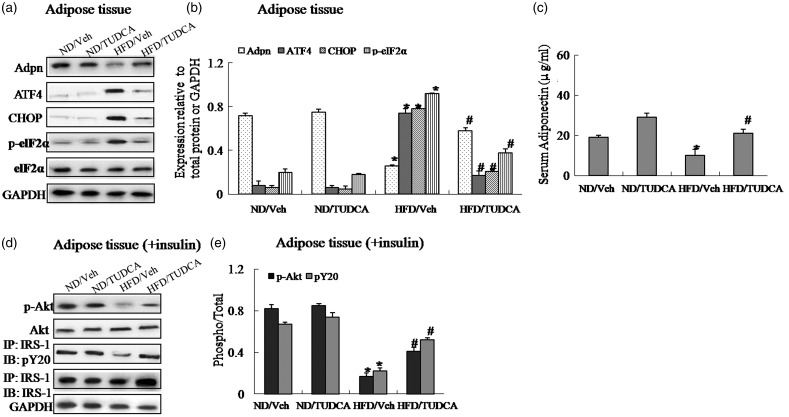Figure 3.
The administration of TUDCA, as an ER stress inhibitor, reverses suppression of adiponectin expression and restores insulin signaling in adipose tissue of obese mice. Mice were distributed into four groups (n = 10 per group): (1) vehicle (normal chow diet, 4% of energy as fat, 3.85 kcal/g, plus 10 µL/g of 0.9% NaCl i.p. injection); (2) TUDCA (normal chow plus 500 mg/kg of TUDCA i.p. injection); (3) high-fat + vehicle (diet containing 60% of energy as fat, 5.24 kcal/g, plus 10 µL/g of 0.9% NaCl i.p. injection); (4) high-fat + TUDCA (high-fat diet plus 500 mg/kg of TUDCA i.p. injection). Daily injections of TUDCA or normal saline solution (vehicle) were initiated after mice were fed a high-fat diet for 8 weeks. Mice were injected once a day (6 p.m.) intraperitoneally (i.p.) with 500 mg/kg of TUDCA or with vehicle for a further 4 weeks. At the end of the study period, half of mice in each group were randomly selected and received an intraperitoneal injection of insulin at a dosage of 2 IU/kg; 15 min after the injection. (a) Protein expression of adiponectin (Adpn), ATF4, CHOP and phosphorylation of eIF2α in adipose tissue. (b) The relative protein quantity of adiponectin, ATF4, CHOP and phosphorylation of eIF2α in adipose tissue. (c) Serum adiponectin. (d) Phosphorylation of IRS-1 and Akt in adipose tissue. (e) The relative protein quantity of p-IRS-1 and p-Akt in adipose tissue. ND, normal diet; HFD, high-fat diet; Veh, vehicle. The relative quantity of proteins was analyzed using Quantity One software. A representative blot is shown and the data were expressed as mean ± SEM in each bar graph. *P < 0.05 (HFD/Veh versus ND/Veh). #P < 0.05 (HFD/TUDCA versus HFD/Veh)

